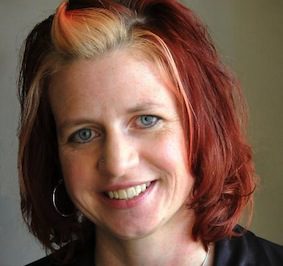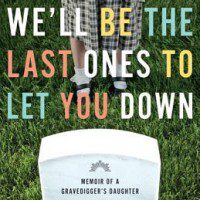Rachael Hanel grew up in cemeteries. “My friends swatted baseballs around diamonds… or swam near Clear Lake’s sandy beach. Instead, I ran around the necropolis, the city of the dead, taking in the fresh air, living and breathing and laughing as those below me no longer could.”
In her memoir on growing up the daughter of a gravedigger in Waseca, MN, Hanel examines the role the dead have taken in her life. She recounts the lives and deaths of those buried in the rural cemeteries her father maintained: a beautiful waitress and her five-year-old daughter who die in a house fire, the Shuch family, brutally murdered by thieves during the Great Depression, her great-grandparents who died within hours of each other during the 1918 Influenza Pandemic, and finally, her own father, who dies suddenly when she is just fifteen.
As a child, she learns subtraction by computing life spans on tombstones. She becomes obsessed with the macabre. While her classmates read Judy Blume, she opts for true crime, pouring over Helter Skelter and The Shocking True Story of Ed Gein. She makes contact with dead relatives using a Ouija board. “My belief in the afterlife was so strong that it sank into my bones and vibrated with realness. It was what my parents believed. The belief was passed down to me, as genetic as the skinny fingers and blue eyes I got from Mom… my inheritance.” She becomes a self-proclaimed “student of death.” It seems appropriate that Hanel’s first newspaper job is writing and typing obits. “It didn’t seem right that people should just disappear,” she says. “I would write everyone’s story if I could.”
It’s this impulse that infuses We’ll Be the Last Ones to Let You Down. Hanel is a writer obsessed with glimpsing the lives of others. The circumstances of Hanel’s life are remarkable, but it’s her wildly imaginative and powerfully empathetic interior life that shines on the page as she places herself in the minds of the bereaved. About a woman who either cannot afford or chooses not to buy a marker for her son’s grave: “Without a gravestone, this once living being will soon not be remembered. But it might be Marlene’s way of protecting herself. She thinks of Michael every day. In her darkest moments, does she try to convince herself it was a dream? Without a marker, with just a vast expanse of grass to gaze on, it could be just a dream.”
*
The dead fascinate us. When I was in college, I read a story online in The New York Times about a brilliant Yale student who died a few weeks before her graduation. A picture of one of the most beautiful girls I had ever seen accompanied a blurb that explained she had died while toiling inside a machine shop in a chemistry lab, investigating the possible use of liquid helium for detecting dark matter. She was killed when her hair became caught in a lathe.

A headline made me aware she had lived. For a few minutes I admired her picture: she is twenty-two and alive and everything still seems possible. I had no answer to the injustice of a twenty-two-year-old dying like that. I closed my laptop on her life. But when I woke up the next day I was still thinking about her. If this was goodbye, how come I felt as if she were touching my hand lightly, for the first time?
I found myself thinking about her from time to time. I wondered, had I gone to Yale, had we met in some science course, would we have been friends? Would we have studied late in the library, drinking coffee together at midnight?
Or would I have moved past her, running across the Yale campus, rushing to class, my eyes downcast, so caught up in my own head, so young, so fearful, so uninvolved? So incapable of understanding just how special the person was who died here?
*
Hanel’s struggle against forgetting the dead takes a personal turn with the sudden death of her father, a colorful man known to his clients as “Digger O’Dell.” Despite their occupation, Hanel’s stoic family doesn’t talk about death or those they love after they die. They are prone to hiding their emotions: “I remember one time I hugged Dad,” she writes. “Our family did not hug. I put my arms around him and squashed my face into his soft belly. I heard Mom give a surprised laugh. I had broken the unwritten rule that said you didn’t do anything or say anything to make people uncomfortable… I never hugged dad again.” When her father dies, Hanel, her mother and brother retreat into their private rooms to grieve. Across every page, we see Hanel struggling against the silence that threatens to erase, definitively, her beloved father. And we see how his death continues to affect her adult life, influencing her choice not to have children because she fears she “would leave them behind in the same way Dad left me,” and intensifying her yearning for intimacy and affection: “It was as if I needed to negate the everyday loss I absorbed in the cemeteries by imagining the hot blood of a living being next to me…. We had a support post in the middle of our basement living room. Alone, in that room, I would hug the post; it approximated the shape of a tall, thin man.”
As we go through life, we are often vaguely aware that one day everyone we know and love will die. We’ll Be the Ones to Let You Down reminds us that death is rarely the end of the story. Toward the end of the book, Hanel describes her father’s burial. At the ceremony, Hanel notices another gravedigger hiding among the trees in the back of the cemetery, waiting for the mourners to leave before he discreetly buries her father. “I see the blue of Swenson’s pickup and him inside the cab, waiting for all of us to leave. And he will follow protocol, not starting his job until we leave for the church basement… he’ll leave no tracks, no sign that he was here. Quickly (you’d be surprised at how quickly), the seams of Dad’s grave will repair themselves and blend in with the rest of the grass.”




